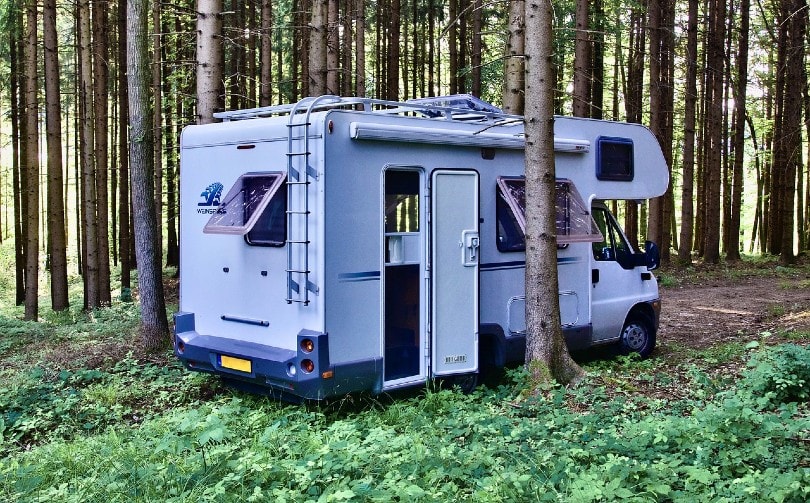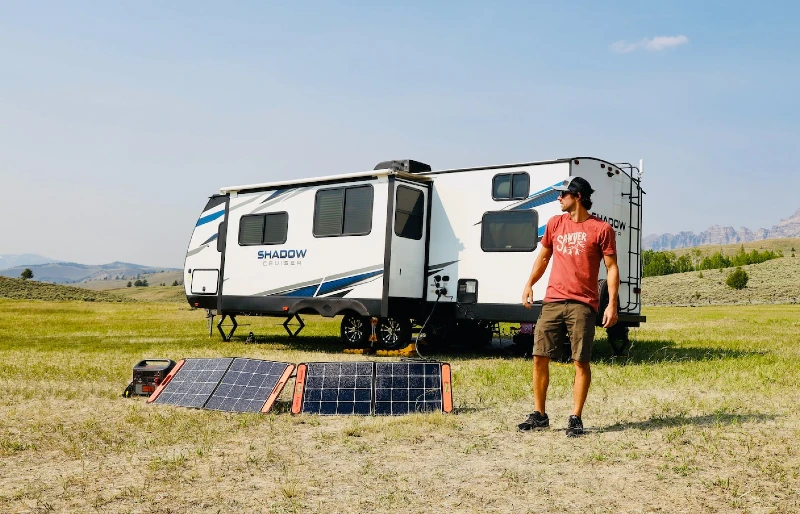How Much Solar Power Do I Need For My RV?
-
Pete Ortiz
- Last updated:

Solar power is slowly but steadily taking over the globe. And, for an RV fan, it can be an excellent investment. Solar panels can serve as a reliable energy source when the sun is up. Plus, they require little maintenance to work properly. How much solar power will you actually need to successfully run an RV, though? On average, 240 watts should be enough to power your recreational vehicle.
That can be achieved with just two 120-watt panels, with a single panel capable of producing 32–33 ampere-hours (Ah) a day. But is that going to be enough for an avid camper? Or maybe you should invest in more solar power? It depends on your driving habits, the hardware/appliances, how many batteries you have, and other factors. Join us, and let’s talk about it all in detail.
| Average Cost for the Project | $600–1000 for a camper van |
| Approximate Installation Time | +/- 2 hours (for a professional) |
| Average Labor Cost | $150–350 for the job |
| Estimated Pay Off Time | 4 to 10 years |
Before You Begin
Upgrading an RV with solar panels is no small deed. First, it’s not particularly cheap. Second, it can be quite a challenge to determine exactly how much solar power you need. Amps, volts, watts—all these techy terms tend to be a bit overwhelming. So, to make matters easier for you, do your best to answer the following questions:
- How much power do you use during the day?
- How much energy can the panels generate?
- Can your battery store enough power?
Once you figure this out, you’ll be able to make the right choice. And remember: no TV, kitchen appliance, or light outlet will work if it doesn’t get enough power. In addition, unless you live somewhere in California or Arizona, the sun won’t always be shining. That’s where the storing part comes in. To accumulate all that solar power gathered by the panels, you need a proper battery.
And sometimes, one battery isn’t enough. No matter how many panels you’ve got, if the battery capacity is low, you’ll have to revert to the generator. At the same time, solar panels do cost a lot. So, buying more than you necessarily need for the RV will, essentially, be a waste of money.
Doing The Camping Test

Wait, how do you know how much solar power the RV needs? The answer is simple: you do a camping test. It would be best to spend three to four days in the wilderness to get the most accurate “readings”. Don’t do anything out of the ordinary: use the recreational vehicle just like you’ve always done. Take showers, fire up the fan/heater, keep the fridge on, and watch TV.
Use a battery monitor to keep tabs on the battery level. A standard voltmeter will also do. The most important thing to remember here: never let the charge drop below 50%. If it does, that will reduce the battery’s lifespan. And if the charge goes out too quickly, that means you might want to buy a second one.
Putting The Numbers Together
Now, if you have a 400 Ah battery kit, and it’s roughly at 50%, that means you’ve successfully consumed 200 Ah. A three-day camping journey equals 60–70 Ah a day. So, that’s how much solar power you’ll need. These are rough estimates, of course. And one more thing: standard car batteries DO NOT work with solar panels.
For that, you’ll have to buy a unit that was specifically engineered to receive and hold solar power. To make it last longer, get an automated switch. Without it, the battery might get overcharged and break down. An inverter (DC to AC) will be necessary as well. Without one, you won’t be able to power your TV, oven, or coffee maker.
Here’s a quick rundown:
- A single 12-volt battery can handle 300 watts of solar panels. That should be enough to power the lights, ceiling fan, TV, and phone.
- Two 12-volt batteries easily work with 400–500 watts. With this much power, you’ll be able to keep the fridge running and use the RV’s furnace.
So, How Many Panels Will Your RV Need?
The next big question is how many solar panels can provide 70 Ah a day? This mostly depends on how much power the panel(s) can generate. There are dozens of different brands out there, and they all have different power outputs. On average, a 100-amp solar panel is good for 30 Ah/day. We recommend investing in three 100-watt panels. That way, you’ll get +/- 90 Ah a day.
This is important: during your trip, it can get cloudy, rainy, or foggy, and the panels won’t be receiving sunlight 24/7. On average, in the US, you can expect to get six hours of sun per day. But with a three-panel setup, you will always have enough power for the van and for creature comfort.

How Much Will Solar Power Cost You?
Solar power isn’t cheap. But, we’ve got good news: you won’t have to empty your bank account to go full solar mode. A three-panel set that’s capable of putting out 70–90 Ah per day will cost you around $700 or more. The actual price will depend on the brand, build quality, and other factors. On average, 100-watt solar panels are available for $200–250.
Now, if you’re not a big fan of using gadgets or taking kitchen appliances on a trip, the setup will cost a lot less. In fact, it’s possible to upgrade your camper van with solar panels for as low as $250. In contrast, folks that take long showers, need the AC (or the heater) running all-day-long, and want fresh coffee every morning might have to spend $1,000 or more
Is Solar Panel Installation Expensive?
Solar panel installation isn’t an easy task. It involves precise work with high-voltage wires, which is why you should hire a professional to handle that. The labor cost is pretty steep: $150 per hour. An experienced electrician will have your caravan packed and running in a couple of hours.
Tips For Saving Solar Panel Energy
With solar energy, every single bit of power counts. Here’s what you can do to preserve it:
- Replace power-hungry HIDs and Halogens in your RV with LEDs.
- Make a habit of unplugging your gadgets when you’re not using them.
- Don’t take long showers. Follow the five-minute rule.
- Don’t run the fan(s) 24/7; go out for at least an hour or two per day.
- Use a smart thermostat (and other kitchen appliances).

Solar Power: Worth It for an RV, Or Not?
Before you go ahead and invest hard-earned bucks in a set of solar panels, take a quick look at the advantages and disadvantages of solar power:
- A beneficial long-term investment.
- Unmatched freedom
- No more noisy generators
- A bit too expensive
- Not suited for cloudy areas
- It might not fit your style
Conclusion
And that concludes our journey into the world of solar power for an RV! As we learned, this technology isn’t particularly cheap. However, if you’re a seasoned caravan driver and don’t see yourself getting tired of this hobby anytime soon, solar panels will be a reasonable investment. True, they won’t pay off in a year or two, but the freedom that you’ll get will be worth it.
Motor homes, campers, trailers, and other rigs can, indeed, benefit from solar panels. They’re 100% eco-friendly, hygienic, and easy to use. You will have to make some calculations, and real-world tests before you figure out exactly how much solar power your recreational vehicle needs, though. Take care, and enjoy your next trip into the wilderness!
You might also be interested in: 9 Free DIY Solar Oven Plans You Can Make Today
Featured Image Credit: Voyagerix, Shutterstock
Contents


